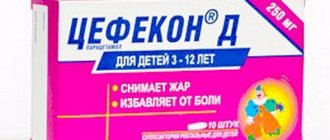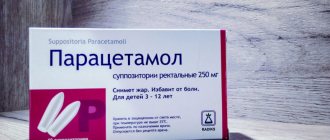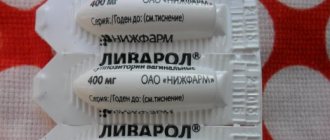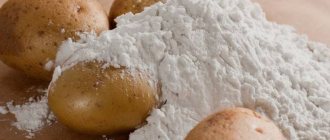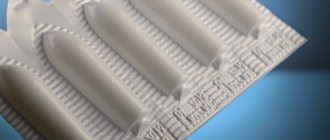Compound
The standard dosage of human interferon alpha-2b in one suppository is five hundred thousand international units, which corresponds to two hundred milligrams of the active component.
Additional chemical compounds in dosage form: fatty substances, emulsifiers, water, sodium chloride, sodium salt of orthophosphoric acid. Kipferon contains two active substances, one of which is alpha interferon type 2b. The content of such recombinant human interferon in one suppository is 500 thousand international units.
The second active ingredient of suppositories is represented by plasma proteins, including immunoglobulins of types M, G and A. Their concentration in 1 suppository is 60 mg. They are called a complex immunoglobulin preparation (abbreviated as CIP), which determines the name of the product. These proteins are obtained from purified donor blood.
Additionally, suppositories include components due to which the suppositories keep their shape, but are sufficiently pliable and quickly dissolve in the intestine, and the active substances in them are evenly distributed. Such ingredients are emulsifier, paraffin wax, sodium hydrogen phosphate and dihydrogen phosphate, purified water, special fat and sodium chloride.
Description of Kipferon
Contains alpha-2B interferon, as well as a complex immunoglobulin preparation. It has anti-inflammatory, immunostimulating, antiviral, antibacterial effects (including against chlamydia). Available in the form of rectal and vaginal suppositories.
Alpha interferon has an antiviral effect due to increased phagocytic activity of monocytes and neutrophils. Promotes the formation of one's own antibodies - immunoglobulins of classes A, G, M. Thus, the drug strengthens the cellular and humoral components of immunity.
Kipferon has anti-inflammatory, immunostimulating, antiviral, antibacterial effects.
KIP contains the main groups of antibodies that are active against chlamydia and other bacteria. These proteins increase the stability and effectiveness of interferon in an inflammatory environment with interferon-degrading proteolytic enzymes of neutrophils and bacteria.
Indications for use:
- Acute intestinal infections at the recovery stage - salmonellosis, typhoid fever, yersiniosis, amoebic and shigellosis dysentery, coli infection, giardiasis.
- Treatment of viral infections - genital herpes, herpes zoster.
- In gynecology - genital candidiasis, gardnerellosis.
- Frequently recurring acute viral diseases of the respiratory system - bronchitis, pneumonia, tracheitis.
- Intracellular infections - chlamydia, mycoplasmosis. Used as part of complex therapy.
- Viral hepatitis.
Contraindications: pregnancy up to 13 weeks, lactation, allergic reaction to the components of the drug.
Side effects: allergies, burning sensation in the vagina when using vaginal suppositories, fever, muscle pain.
Kipferon should not be used before the 13th week of pregnancy.
Action of Kipferon
Interferons present in the dosage form perform specific functions in the body aimed at combating infectious agents. A course of drug therapy helps eliminate the inflammatory process and speed up recovery. Has a pronounced antiherpetic effect.
In the annotation for the suppositories, no negative side effects are noted, however, in very rare cases, a small patient may have an allergic reaction to any ingredient of Kipferon. Allergies can vary in severity - from slight itching to severe swelling. In this case, the use of the product is stopped immediately and suppositories cannot be used in the future.
The manufacturer does not mention cases of negative effects of suppositories in a larger dose than prescribed by the doctor. Kipferon can be used in conjunction with many other medications, for example, for bacterial damage to the intestines, it is prescribed with Sumamed, Flemoxin and other antibacterial agents.
Indications
- Infectious processes in the respiratory tract.
- Inflammation of the genitourinary system.
- Disturbance of the intestinal microbiome in childhood.
- Herpetic infection.
Do not use only if the following factors are detected: allergy to the components of the drug, pregnancy, breastfeeding.
Kipferon is in demand in the following situations:
- For acute respiratory infections of different nature - laryngitis, tracheitis, otitis and other pathologies;
- For bacterial or viral infections of the oropharynx;
- For rotavirus and viral hepatitis;
- For a bacterial intestinal infection, manifested by loose stools and vomiting, for example, with dysentery, salmonellosis or infection with pathogenic E. coli;
- With the flu;
- With intestinal dysbiosis;
- When infected with herpes viruses, for example, with chickenpox or herpes stomatitis;
- For chlamydia.
The drug can also be prescribed for prophylaxis, for example, with frequent acute respiratory viral infections or before a planned operation.
The only reason to refuse treatment with Kipferon is intolerance to any component of such suppositories. There are no other contraindications in the instructions for the candles.
Indications for use
The range of applications of this drug is impressive, because Kipferon suppositories are widely used to treat a wide variety of diseases. In particular, they help with various intestinal infectious diseases of viral origin. The drug is often used to treat anal fissures and dysbacteriosis. Men are prescribed suppositories for acute and chronic forms of prostatitis. The medicine quickly copes with infections of the respiratory system, in particular laryngitis, pneumonia, bronchitis, etc. Indications for use are nonspecific inflammatory diseases of the genital organs, candidiasis, genital herpes, urogenital chlamydia. In some cases, suppositories are prescribed for the treatment and prevention of acute respiratory viral infections. By the way, suppositories are often combined with other medications to achieve maximum effect.
Instructions for use
When prescribed to children, Kipferon suppositories are administered only rectally. Manipulation is recommended to be carried out after defecation.
Dosage and regimen depend on the patient’s age:
- For infants in the first year of life, the medication is prescribed one suppository once a day.
- At the age of one to 3 years, the drug is used twice, 1 suppository.
- For a child over three years of age, the frequency of administration of suppositories can increase to 3 times a day. One dose involves the administration of one suppository.
The duration of use for viral infections and dysbacteriosis usually ranges from 5 days to one week. When infected with bacteria (for example, with purulent sore throat), the course of use lasts 7-8 days.
Suppositories are inserted into the rectum or vagina. The treatment regimen is determined by the doctor based on the identified disease. Can be used as part of combination therapy.
Dosage options
- Respiratory tract infections: one suppository per day for a child up to one year old; one candle twice a day for children aged one to three years; one candle three times a day after three years. Within five to seven days.
- Female genitourinary system infections: 1-2 suppositories twice a day. For ten days.
Analogs
There are medications with similar active ingredients and medicinal properties.
Viferon
The drug is presented as suppositories, ointment and gel. It is prescribed even to premature babies in the form of suppositories.
What experts will tell you about this drug - watch the video.
Genferon Light
This medication in suppositories is used from birth.
Grippferon
It comes in two forms (spray and nasal drops) and is allowed at any age.
In addition, the child may be prescribed other drugs with similar therapeutic effects, for example:
Immunofan suppositories
They are allowed from 2 years of age and are also available in the form of a nasal spray and injection. The drug is used for viral infections and immunodeficiency conditions.
Galavit
The drug Galavit, which is presented in suppositories, injections and tablets. It is prescribed to children for frequent acute respiratory viral infections, adenoiditis, stomatitis, sore throat and other diseases from the age of 6 years.
Imudon tablets
Due to the presence of bacteria in the lysates, this drug helps with stomatitis, tonsillitis and other diseases of the oropharynx. In childhood, it is prescribed from 3 years of age.
Ingavirin capsules
This medicine with antiviral effect is used in children over 7 years of age.
This remedy, based on bacterial lysates, is used for the common cold, adenoiditis, tonsillitis and other diseases. In pediatrics it is used from 3 months.
Kagocel tablets
They are prescribed from the age of three for herpes and flu.
Arbidol
The drug Arbidol containing umifenovir. It is in demand for viral diseases and is available in several forms (suspension, capsules, tablets). Children are prescribed it from the age of two.
Orvirem syrup
Orvirem syrup, the effect of which is provided by rimantadine. This remedy is used for influenza in children over one year of age.
Cycloferon tablets
They activate the synthesis of interferon in the patient’s body and are used from 4 years of age.
The drug Acyclovir
This medicine is produced in different forms (ointment, cream, powder, tablets, etc.) and is prescribed for infection with herpes viruses.
Some parents, instead of Kipferon, decide to treat their child with homeopathic remedies (Ergoferon, Oscillococcinum, Aflubin, Anaferon). However, many pediatricians, including the popular doctor Komarovsky, doubt their effectiveness and warn that they cannot be a full replacement for immunomodulatory and antiviral drugs. In addition, you should not independently give your child any drugs that affect his immune system.
Release forms and composition of the drug Kipferon
The balanced composition of the drug allows it to be used for the treatment of both infants and adults.
Kipferon - candles for children, the reviews of many parents about which are mostly positive.
The antiviral agent contains:
- CIP, complex immunoglobulin preparation, 60 mg;
- recombinant strains of bacteria capable of producing interferon with a biological activity of 500 thousand IU;
- additional substances that promote the release of the active ingredient and its uniform distribution: emulsifier, fat, paraffin, sodium salts, water.
The suppositories are white, shaped like a cylinder, and dense to the touch. Candles, 5 pcs., packed in special plates. The cardboard box contains instructions, as well as 1 or 2 blisters.
Reviews
Treatment with Kipferon is reviewed differently, because the effectiveness of such a remedy is judged subjectively, and its effect on the child’s body during use is different, since it depends on the severity of the disease and on the individual characteristics of the patient.
For some children, suppositories help and the condition improves in just a few days. Other parents complain about the lack of any positive effect of the medication. The greatest effect from treatment with Kipferon is observed in children who were given suppositories in the first three days of the disease. However, any adverse reactions to the drug are often not mentioned.



